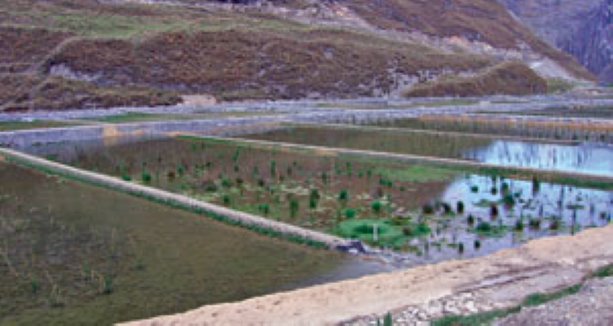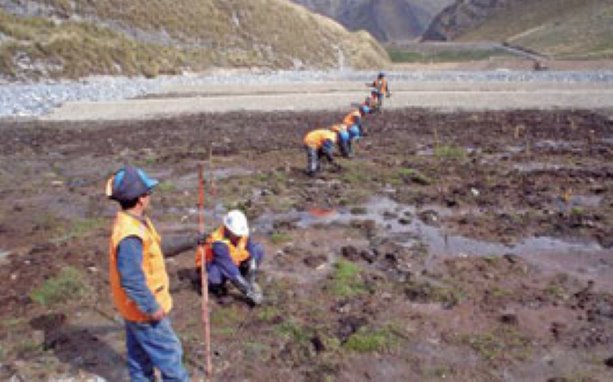High in the rugged Peruvian Andes, a Vancouver engineering firm with its sister company has designed and built a series of ponds that serves as a natural eco-system of wetlands that cleanses run-off mineral-contaminated water from an operating mine’s waste-rock dump.
Water Treatment
Peru
High in the rugged Peruvian Andes, a Vancouver engineering firm with its sister company has designed and built a series of ponds that serves as a natural eco-system of wetlands that cleanses run-off mineral-contaminated water from an operating mine’s waste-rock dump.
Bullrush-like plants in ponds, with migrating birds, form part of the landscape near the operating mine and provide a sustainable environmental solution in the Tucush Valley.
“It (Compania Minera Antamina S.A.) is one of the largest copper-zinc mines in the world,” says Harvey McLeod, who served as project leader for the venture by Klohn Crippen Berger and affiliate Louis Berger Group.
The two companies collaborated with a project team to design, construct and monitor the natural water treatment facility, which through a series of stages removes suspended sediment, nitrates, and dissolved mineral.
“Nitrates used in blasting of the rock and natural leaching of metals from the waste rock are transported with surface water run-off into the Tuscush Valley,” he says. The concerns centre around surface water related to the area’s seasonal rainfall. Most of the water used in the processing of mineral on site is recaptured and used again in the mine.
The natural treatment facility, which cost $2 million US to build uses a unique combination of sediment ponds, serpentine and high-elevation wetlands to capture any minerals and sediment.
“The challenges were designing a natural wetlands in the high rainfall and high elevation rugged mountain terrain,” he says.
The site is located at an elevation of 4,200 metres with steep mountains surrounding it, says McLeod, describing the peaked Andes walls.
At that elevation and topography, the difficulty consisted of finding a cost-efficient solution that would work today and also find a future natural but cost-effective means of controlling metal contaminates when the mine closed. A conventional treatment facility would have required someone on site when the mine ceased operation.
The alpine terrain-like site was covered with grasslands and boulder-filled soil.
The site also presented problems in that the valley was narrow and it was covered with low-strength clay. “The clay presented a significant geotechnical challenge,” he says.
The decision was made to try to employ a natural wetlands filtration system. Such a structure would become the largest high elevation wetland in the world. Building this kind of natural wetland filtration system was not a new concept. It had been tried in some mine sites worldwide, including in Canada, but it was a unique approach at such a high elevation. Wetlands are also a part of the natural habitat, which is gradually disappearing around the world, and this was a means of adding new wetlands into the terrain conditions.
Sediment control structures and reinforced mats had to be constructed on site to stabilize the ground because of the soft clay. “On the biological side, we started looking at what plants could survive in the area and were able to mitigate the nutrients that the wetlands were trying to remove,” he says, adding crews canvassed plants for a 10 to 20 kilometre range.
Plants were brought back to the site, a greenhouse was built to store and propagate them and planting was undertaken over the area, which measures approximately six hectares in size.
Questions that the project had to answer were ones such as how many plants per hectare were needed to absorb the metals and nutrients that drained into the wetlands? Also, many of the plants will naturally die off and biodegrade while still others may have to be removed every five years or so and new ones planted to ensure the effectiveness of the vegetation in absorbing the nutrients and minerals.
The project was successfully completed and won Klohn Crippen Berger Ltd. a Consulting Engineers of B.C. Award of Merit in the category of natural resources, energy and industry.
“The real benefit of it is that you are creating something that is more natural rather than a civil engineered water treatment facility,” says McLeod. “You want environmental solutions that work with nature and do not require long term operations that might need to be maintained forever.”

1/2
The natural treatment facility uses a unique combination of sediment ponds, serpentine and high-elevation wetlands to capture any minerals and sediment.

2/2
The challenges were designing a natural wetlands in the high rainfall and high elevation rugged mountain terrain.











Recent Comments
comments for this post are closed